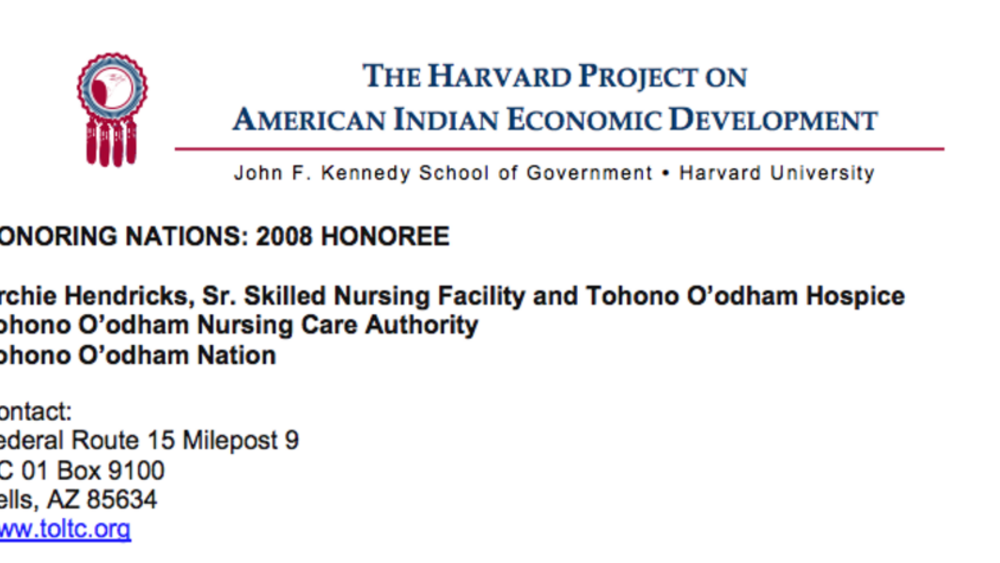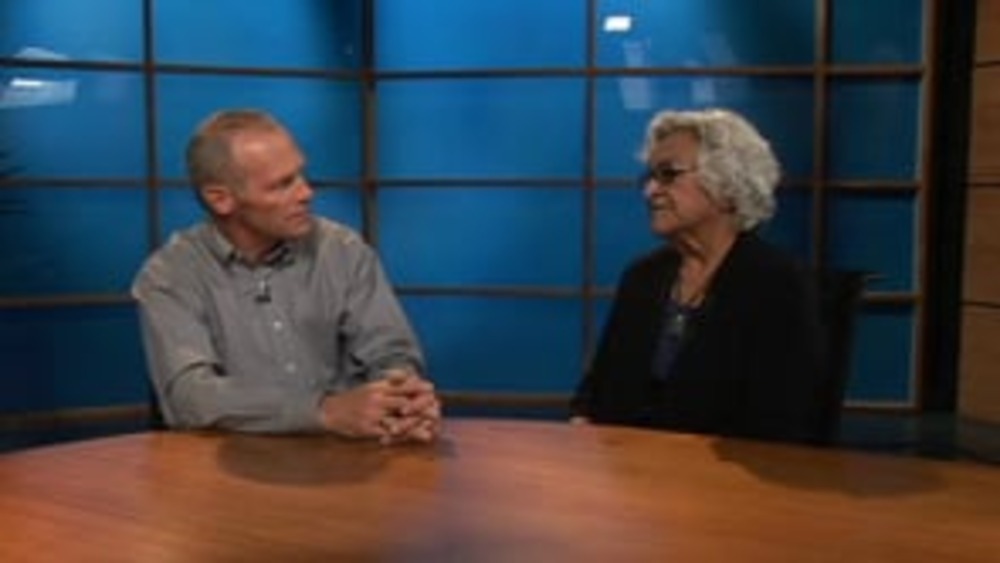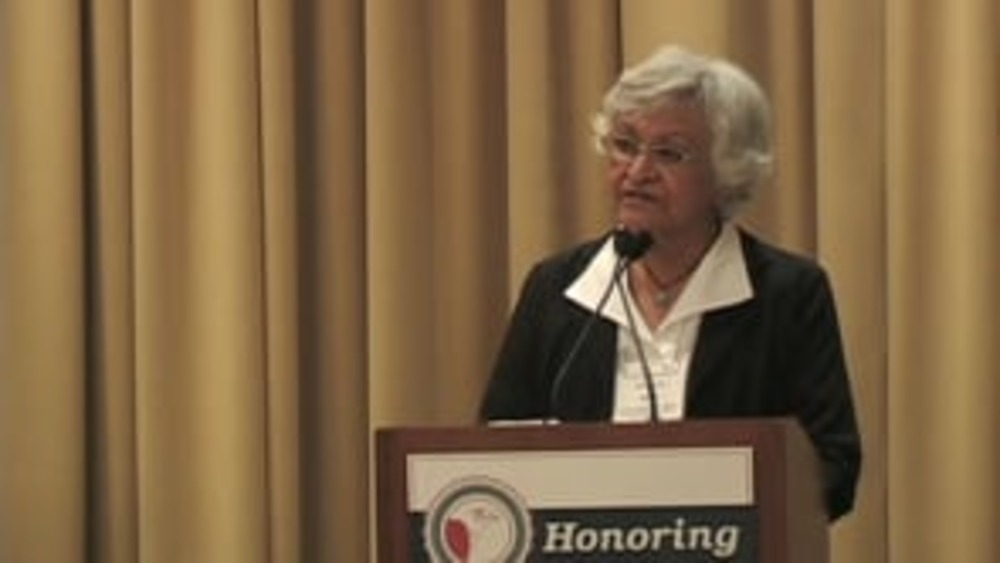This video -- produced by the Tohono O'odham Nursing Care Authority using its monetary award from the Harvard Project on American Indian Economic Development's Honoring Nations awards program -- explains the history and development of the Archie Hendricks, Sr. Skilled Nursing Facility and the Tohono O'odham Hospice, which are located on the Tohono O'odham Nation in Arizona.
Additional Information
Tohono O'odham Nursing Care Authority. "Tohono O'odham Nursing Care Authority - Our Story." Rock Steady Productions. Sells, Arizona. 2009. Film.
This Honoring Nations "Lessons in Nation Building" video is featured on the Indigenous Governance Database with the permission of the Harvard Project on American Indian Economic Development.
Transcript
[Singing]
Frances Stout:
“I was on what they call an advisory committee and the group was very passionate about what they did. They were determined to build a facility in spite of the cost. They were very determined to bring their people home. This past year we were honored by Harvard University and their project, which is called Honoring Nations, with an award. It gave us an opportunity to share our story and we feel that the information that we have given will help others perhaps be as successful as we are. This facility opened in November of 2003 and it’s located on sort of in the middle of the reservation close to the Mexican border on Indian Route 15.
[Singing]
When we share our story about success, we always mention passion, that we feel that if someone doesn’t champion the idea that probably it just won’t go. In our case, it was a group of ladies who just kept approaching the nation asking, ‘Do we have money now to start the program?’ And then it moved to an advisory group, which actually by that time, we had money. And we also need a government that listens to the people and who honors the elder because I think we’ve seen a lot of times when someone said, ‘Yes, we do honor our elders,’ but there was no action taken to care for them. In our case, we have executives who followed through with the money, appropriated the money and this gave us the ability to move forward with the building, staffing and the programs that we have here.
Funding for the facility comes from gaming, but not all of it. One third is from our, we’re reimbursed by ALTCS which is the Arizona Long-Term Care System, which is Medicaid. Then there are a few that are on Medicare. We also are licensed to take veterans so if we do the Veterans Administration would pay for their care here. There are very few private pay. The rest, anything that’s not paid for by any of these entities, then our tribe then pays for it.
As far as jobs go, we have, especially all our managers, they are all O’odham except one and they’ve all had special training. We’ve been able to have consultants come in and work directly with them, help them with policy making for their specific department, help them even if need be, be certified. So this has been a very outstanding thing for the people here on the reservation.â€
Caroldene Garcia:
“After a couple of months of being here and having the board, dealing with the board, working with the board, I happened to have the opportunity with the administrator -- who also runs another facility, who has their own HR [human resources] department -- and was willing to provide that training for me. So the board allowed me to do that, set up a contract where she would monitor me and give me some advice and help me upgrade my skills that I already had in place.â€
Frances Stout:
“We truly bend over backwards to bring our staff in and to keep them. We have bonuses for our nurses. The benefits for the, that the nation provides for all their employees are very, very good. This includes medical care, dental care and a 401k. We do have housing and we have housing also that takes care of the shifts. For instance, if we have person on 12-hour shift and they want to spend a couple of nights here, we have facilities for them.
[Singing]
In the area of communication, we do try to communicate quarterly with the districts, with our oversight committee, with the executive. And we do feel that any plan that we have, we try to maintain transparency with everyone so that there are no surprises to anyone and then we also get their input. We find now that planning is very important and we try to be very sure that we implement. It’s not just a plan that’s put on the shelf. We do work at implementing every goal.â€
Charlene Conde:
“In addition to the Archie Hendricks Skilled Nursing Facility, we also have the hospice program. The hospice program is taking care of O’odham people that are reaching their life’s end. Before we had a hospice here on the nation, our people had to go out to the city and the hospitals, Tucson, wherever they’re sent to get hospice care there, so this is a good thing for our people. I worked as a CNE on the nursing unit before I transferred over to the hospice care. I wanted to work for my people.â€
[Singing]
Frances Stout:
“We have a mission. This mission has not been changed since I’ve been because it’s such a strong mission. It sets up the reason for our existence and we feel very passionate about it. It talks about continuum of care and that’s one of the new passions that we have is hoping to put together a model of continuum of care for our aging population we do have, beginning with the nursing care facility here.
[Music]
We also have started an organization or a consortium. It’s called the Elder Care Consortium and we realized that there were many issues and this group alone could not solve the problems. So we, this is how the consortium came into being and we, it consists of the tribal Health and Human Services, the Indian Health Service, and the community college, and of course us. So the four entities meet monthly, we talk about the issues of aging and we have put together a white paper for the new administration so that they see what we see and we also have a few recommendations for them. We will continue to update that white paper as time goes on.â€
Priscilla Ortiz:
“I work with children. I worked at a school and then from school I went to elders and I enjoy doing what I do. I love it. I like being a clown, I like letting the residents know that we’re here for them. And we did wonderful. I didn’t understand their language. Now they’re teaching me how to say certain words. I’ll say it, they laugh at me, but they correct me, which is okay. It’s been a rewarding thing for me to learn their language.â€
[O'odham language]
Frances Stout:
“I think right in the beginning that was the main thing we wanted to do was to deliver care in accordance with what we call Himdag. Himdag is our way of life and that includes foods that we eat, some of the traditions that we do and the medicine person, having the medicine person come and always be I would say almost on call.â€
Lisa Folson:
“We made this healing room, one of the nurses Richard Hix made this, painted this area and it was requested on behalf of the staff, O’odham here mainly to bring the medicine people in and to have healing here. It’s really good that we have this because there’s a lot of people that don’t recognize our culture, don’t recognize our tradition, but because we’re at home, they see this as something that we need and it’s just, it’s like you going to the doctor, or it's somewhere where you can pray. So it would be something like your church or your temple.â€
Frances Stout:
“There were many obstacles. I think the first one was staffing the place. We do not have very many professional people here on the reservation so it was, we needed to go out and look. And I mean we went all over the country looking for a DON, an administrator. The administrator has to be licensed and we went through three administrators, the third one being our present administrator, and he’s done a fantastic job. So that was the biggest obstacle. The other was finding a Director of Nursing Services and we went through several before we found our present one who was willing to stay and I think she’s doing a very good job. That obstacle is the fact that we are out in the middle of the desert and we are, people, our professional people have to commute and that gets old after awhile. I think we pretty much accomplished what we set out and that’s get the building up, to bring most of our people home. There are a few who cannot come home because of the level of care. However, we do keep in touch with those people. Perhaps at some time in their life they may be able to come home.â€
[Singing]



